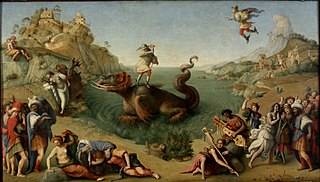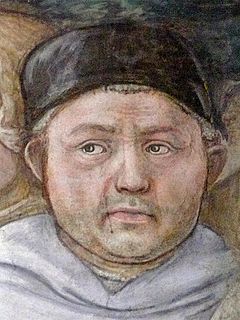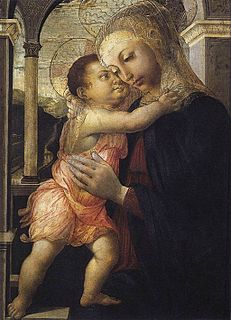
Filippino Lippi was an Italian painter working in Florence, Italy during the later years of the Early Renaissance and first few years of the High Renaissance.

Piero di Cosimo, also known as Piero di Lorenzo, was an Italian painter of the Renaissance.

Pietro Perugino, born Pietro Vannucci, was an Italian Renaissance painter of the Umbrian school, who developed some of the qualities that found classic expression in the High Renaissance. Raphael was his most famous pupil.

Fra'Filippo Lippi, also known as Lippo Lippi, was an Italian painter of the Quattrocento and a Carmelite Priest.

Madonna in Glory with Seraphim is a painting by the Italian Renaissance painter Sandro Botticelli, executed c. 1469–1470. It is housed in Galleria degli Uffizi.

The Solly Madonna by the Italian Renaissance artist Raphael was painted sometime between 1500 and 1504.

The Conestabile Madonna is a small painting by the Italian Renaissance artist Raphael, executed c. 1502–1504. It was likely the last work painted by Raphael in Umbria before moving to Florence.

The Madonna of the Magnificat, Italian: Madonna del Magnificat, is a painting of circular or tondo form by the Italian Renaissance painter Sandro Botticelli. It is also referred to as the Virgin and Child with Five Angels. In the tondo, we see the Virgin Mary writing the Magnificat with her right hand, with a pomegranate in her left, as two angels crown her with the Christ child on her lap. It is now in the galleries of the Uffizi, in Florence.

The Madonna della Loggia is a painting attributed to the Italian Renaissance artist Sandro Botticelli, dating to c. 1467. A tempera on panel work, it is located in the loggia of Uffizi, Florence, Italy.

Madonna of the Harpies is an altarpiece in oils by Andrea del Sarto, a major painter of the High Renaissance. It was commissioned in 1515 and signed and dated by the artist in 1517 in the inscription on the pedestal; it is now in the Uffizi in Florence. It was praised by Vasari, and is arguably the artist's best-known work.

Madonna Enthroned, also known as the Ognissanti Madonna, or just Madonna Ognissanti, is a painting by the Italian late medieval artist Giotto di Bondone, housed in the Uffizi Gallery of Florence, Italy.

The Maestà is a painting by the Italian artist Cimabue, executed around 1280 and housed in the Musée du Louvre in Paris.

Pietà is a painting by the Italian Renaissance artist Pietro Perugino, executed around 1483-1493, and housed in the Uffizi Gallery, Florence.

Madonna with Child is a painting by the Italian Renaissance artist Filippo Lippi. The date in which it was executed is unknown, but most art historians agree that it was painted during the last part of Lippi's career, between 1450 and 1465. It is one of the few works by Lippi which was not executed with the help of his workshop and was an influential model for later depictions of the Madonna and Child, including those by Sandro Botticelli. The painting is housed in the Uffizi Gallery, Florence, Italy, and is therefore commonly called “The Uffizi Madonna” among art historians.

Cimabue's Celebrated Madonna, originally called Cimabue's [Celebrated] Madonna [is] Carried in Procession through the Streets of Florence, is an oil painting by English artist Frederic Leighton. Measuring more than two metres tall and more than five metres wide, the canvas was painted by Leighton from 1853 to 1855 in Rome as his first major work.

Andrea di Niccolò, also Andrea di Niccolò di Giacomo, (1440–1514) was an Italian painter of the Sienese School.

The Panciatichi Holy Family or Panciatichi Madonna and Child is a 1541 oil on panel painting by Bronzino, signed on a stone in the bottom left corner. It is now in the Uffizi in Florence, where it was first recorded in the Tribuna in 1704, where it remained until 2010, when it was moved as part of the "New Uffizi" project. Preparatory drawings for the work are in the Uffizi's Gabinetto dei Disegni e delle Stampe and in the Phillips collection in London.

Madonna and Child with the Infant Saint John the Baptist is an oil on panel painting by Pontormo, now in the Uffizi, whose Gabinetto dei Disegni e delle Stampe also houses a preparatory drawing for the work. The two theories on its dating are 1534-1536 and Antonio Natali's theory of 1529–1530.

Madonna and Child is a 1450 tempera on panel painting by Jacopo Bellini, now in the Uffizi in Florence. It was bought for its present home by Corrado Ricci in 1906 from a monastery in Lucca in 1906, where it had been spotted by the antiquarian Costantini, with the sale provoking several polemics in the newspapers.

Madonna and Child is an oil on panel painting by Cima da Conegliano, created c. 1504, that now hangs in the Uffizi in Florence. It has an early copy attributed to Antonio Maria da Carpi, now in the Musei civici di Padova.




















